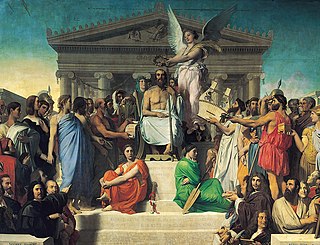
Jean-Auguste-Dominique Ingres was a French Neoclassical painter. Ingres was profoundly influenced by past artistic traditions and aspired to become the guardian of academic orthodoxy against the ascendant Romantic style. Although he considered himself a painter of history in the tradition of Nicolas Poussin and Jacques-Louis David, it is his portraits, both painted and drawn, that are recognized as his greatest legacy. His expressive distortions of form and space made him an important precursor of modern art, influencing Picasso, Matisse and other modernists.

The Discovery of America by Christopher Columbus is the name of a painting by artist Salvador Dalí, begun in 1958 and finished in 1959. It is over 14 feet tall and over 9 feet wide, one in a series of large paintings Dalí did during this era.
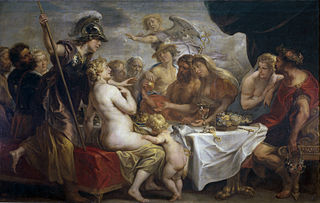
A figure painting is a work of fine art in any of the painting media with the primary subject being the human figure, whether clothed or nude. Figure painting may also refer to the activity of creating such a work. The human figure has been one of the constant subjects of art since the first stone age cave paintings, and has been reinterpreted in various styles throughout history.

Apotheosis is the glorification of a subject to divine level. The term has meanings in theology, where it refers to a belief, and in art, where it refers to a genre.
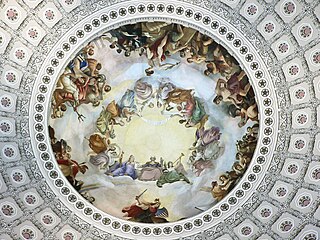
The Apotheosis of Washington is the fresco painted by Greek-Italian artist Constantino Brumidi in 1865 and visible through the oculus of the dome in the rotunda of the United States Capitol Building. The fresco is suspended 180 feet (55 m) above the rotunda floor and covers an area of 4,664 square feet (433.3 m2). The figures painted are up to 15 feet (4.6 m) tall and are visible from the floor below. The dome was completed in 1863, and Brumidi painted it over the course of 11 months at the end of the Civil War. He was paid $40,000 for the fresco.
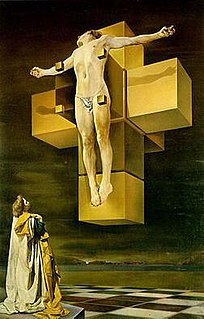
Crucifixion is a 1954 oil-on-canvas painting by Salvador Dalí. A nontraditional, surrealist portrayal of the Crucifixion of Jesus, it depicts Christ on the polyhedron net of a tesseract (hypercube). It is one of his best known paintings from the later period of his career.

Grande Odalisque, also known as Une Odalisque or La Grande Odalisque, is an oil painting of 1814 by Jean Auguste Dominique Ingres depicting an odalisque, or concubine. Ingres' contemporaries considered the work to signify Ingres' break from Neoclassicism, indicating a shift toward exotic Romanticism.
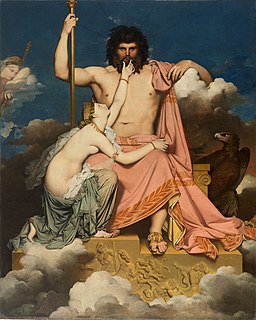
Jupiter and Thetis is an 1811 painting by the French neoclassical painter Jean Auguste Dominique Ingres, in the Musée Granet, Aix-en-Provence, France. Painted when the artist was yet 31, the work severely and pointedly contrasts the grandeur and might of a cloud-born Olympian male deity against that of a diminutive and half nude nymph. Ingres' subject matter is borrowed from an episode in Homer's Iliad when the sea nymph Thetis begs Jupiter to intervene and guide the fate of her son Achilles; who was at the time embroiled in the Trojan War.

Galatea of the Spheres is a painting by Salvador Dalí made in 1952. It depicts Gala Dalí, Salvador Dalí's wife and muse, as pieced together through a series of spheres arranged in a continuous array. The name Galatea refers to a sea nymph of Classical mythology renowned for her virtue, and may also refer to the statue beloved by its creator, Pygmalion.

Odalisque with Slave is an 1839 painting by Jean-Auguste-Dominique Ingres commissioned by Charles Marcotte. Executed in oil on canvas, it depicts a nude odalisque, a musician, and a eunuch in a harem interior. The painting is in the Fogg Art Museum in Cambridge, Massachusetts. It is a classic piece of Orientalism in French painting.

The Source is an oil painting on canvas by French neoclassical painter Jean Auguste Dominique Ingres. The work was begun in Florence around 1820 and not completed until 1856, in Paris. When Ingres completed The Source, he was seventy-six years old, already famous, and president of the École des Beaux-Arts. The pose of the nude may be compared with that of another by Ingres, the Venus Anadyomene (1848), and is a reimagination of the Aphrodite of Cnidus or Venus Pudica. Two of Ingres' students, painters Paul Balze and Alexandre Desgoffe, helped to create the background and water jar.

Venus Anadyomene is a painting by the French painter Jean-Auguste-Dominique Ingres. It is now held at the Musée Condé, Chantilly, France. It is a female nude of the Venus Anadyomene type, showing the goddess Venus rising from the sea.

The Ambassadors of Agamemnon in the tent of Achilles is an 1801 painting by Jean-Auguste-Dominique Ingres, produced for the Prix de Rome competition. It is now in the École nationale supérieure des beaux-arts in Paris.

The Martyrdom of Saint Symphorian is an 1834 painting by Jean-Auguste-Dominique Ingres. It shows the death of Saint Symphorian, the first Christian martyr in Gaul. Painted in oil on canvas and measuring 407 x 339 cm, it is now in Autun Cathedral. Although Ingres considered the painting—completed only after ten years of diligent work—one of his crowning achievements, it was criticized harshly when he exhibited it in the Paris Salon of 1834. It subsequently has been considered emblematic of Ingres' misguided ambition to excel as a history painter.

La Dormeuse de Naples was an 1809 painting by the French artist Jean-Auguste-Dominique Ingres, now lost. He reused the pose in two later works, Odalisque with Slave (1839) and Jupiter and Antiope (1851).

Romulus’ Victory Over Acron is a painting by the French Neoclassical artist Jean-Auguste-Dominique Ingres. Completed in 1812, Ingres’ source for this subject comes from Plutarch’s Life of Romulus. The painting depicts the war that resulted from the Roman abduction of the young Sabine women in an effort to remedy the shortage of women in the newly founded city of Rome. In retaliation Acron, the king of the neighbouring tribe, the Caeninenses, declared war upon the Romans. He and his tribesmen are mercilessly defeated and their city is sacked by the Romans.

Oedipus and the Sphinx is a painting by the French Neoclassical artist Jean Auguste Dominique Ingres. Originally a student work painted in 1808, it was enlarged and completed in 1827. The painting depicts Oedipus explaining the riddle of the Sphinx. An oil painting on canvas, it measures 189 x 144 cm, and is in the Louvre, which acquired it in 1878.

